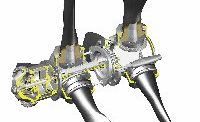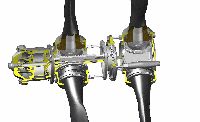


de Havilland Propellers
| The de Havilland company built, among others,
Hydromatic propellers under license from Hamilton Standard. Propellers built by de Havilland functioned the same as Hamilton Standard's and the following drawings give additional insight into the construction of propellers manufactured by both companies. |
 |
 |
 |
Video: de Havilland Hydromatic Airscrew Manufacture
Video: de Havilland Hydromatic Airscrew Installation
de Havilland Contra-Rotating Propeller Pitch Change Animations
by Sergio Pasquali
 |
 |
 |
|
De Havilland and Rotol Contra-Rotating Propellers by Tom Fey During WWII, both de Havilland and Rotol produced contra-rotating propeller sets for the British military, although none went into production or service during the war years. Contra-rotating propellers offered a way to eliminate the torque that adversely affected the handling of tail-dragger aircraft, especially during take-offs and go-arounds. The increased blade area of contra-props could absorb the ever-increasing horsepower of engines while maintaining tolerable propeller diameters and landing gear heights. There was also a theoretical gain of 1 to 3% in propulsive efficiency due to recovery of the swirl energy off the fore propeller, however this proved difficult to achieve in practice. Both the de Havilland and Rotol contra-props used a similar operating principle, specifically, a hydraulic cylinder at the front of the propeller that translated fore and aft to control blade pitch via a rack-and-pinion (de Havilland) or pivoting linkages (Rotol) attached to the base of the blades. The de Havilland propellers used split hubs while Rotol used one-piece hubs. A single propeller governor supplied high-pressure oil to one side or the other of the piston via oil tubes in the bore of the fore propeller shaft. Pitch change to the aft propeller was conveyed through a heavily-loaded bearing that translated back and forth on the propeller shaft. The inner race of the translation bearing was attached to the fore propeller linkages while the linkages for the aft propeller were attached to the outer race. Since both of the bearing races spun in opposite directions, the rotational speed of the bearing was relatively high at twice propeller rpm. Because of the linkage system, the pitch change occurred in lock-step and to the same degree in each propeller; however the pitch of the aft propeller blades were indexed 1° to 3° finer than the fore prop to accommodate the velocity and altered airstream angle of attack coming into the aft prop disc from the fore propeller. The de Havilland contra-prop had a circular oil reservoir surrounding the bearing, which automatically fed oil to the bearing when a defined sequence of rpm changes were performed; Rotol units used grease to lubricate the translation bearing. De Havilland contra-rotating propeller units were used in experimental Merlin and Griffon-powered Spitfires, an experimental Hawker Tornado, the Martin Baker M.B.5, SARO Princess, three Griffon-powered P-51 unlimited-class air racers, and one airworthy F.47 Seafire. The dH contra-prop went into production for the AVRO Shackleton of which 185 were built. The Rotol contra-prop was also used experimentally in Spitfires, the Hawker Tornado, Hawker Tempest MK III, Supermarine Seagull, and the SO.8000 Narval. Rotol contra-props went into production use in the F.47 Seafire (90 produced), SupermarineSeafang (9), Short Sturgeon (25), and the Westland Wyvern (130). Rotol dual rotation propellers were also used in the Bristol Brabazon and the Fairey Gannet, however these were technically coaxial propellers (separate engine drive and pitch change system for each blade set) and are an interesting subject all their own. Short Video Showing the Precious Metal de Havilland Propeller Feathering |